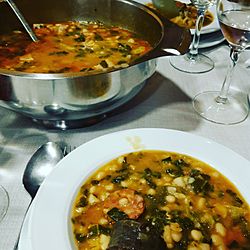Cocido montañés facts for kids

Cocido montañés
|
|
| Alternative names | Puchera montañesa Potaje |
|---|---|
| Type | Stew |
| Course | Main course |
| Place of origin | Spain |
| Region or state | Cantabria |
| Serving temperature | Hot |
| Main ingredients | White beans, collard greens, pork |
| Variations | Cocido lebaniego, fabada asturiana, olla podrida, cassoulet |
Cocido montañés is a super hearty and warm Spanish stew. It means 'highlander stew' or 'mountain stew' and comes from the beautiful region of Cantabria in northern Spain. It's a very popular dish there, especially when it's cold outside!
This delicious stew has been around since the 1600s. People first made it to help them stay warm and full in the chilly, wet weather of the Cantabrian mountains. That's why it's usually eaten in winter, often for lunch, which is the biggest meal of the day in Spain. It's a very filling meal with lots of calories, perfect for keeping you energized!
What's in Cocido Montañés?
Cocido montañés is packed with tasty ingredients. It has two main vegetables:
- Dried large white beans, which are soaked in water overnight before cooking.
- Collard greens, also known as berza. Sometimes, if collard greens are hard to find, people might use cabbage instead. Some recipes also use a local red bean called caricu montañés instead of white beans.
The other important parts of the stew are called compangu. This word refers to the yummy meat ingredients, which traditionally come from a pig. These include:
- Bacon (tocino)
- Pork ribs (costilla)
- Black pudding (morcilla)
- Sausage (chorizo)
These ingredients make the stew very rich and flavorful.
See also
- In Spanish: Cocido montañés para niños

